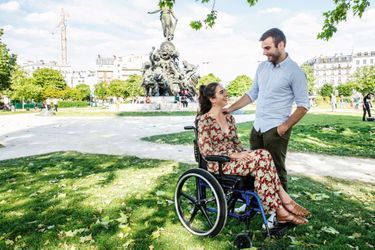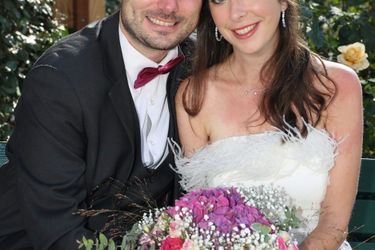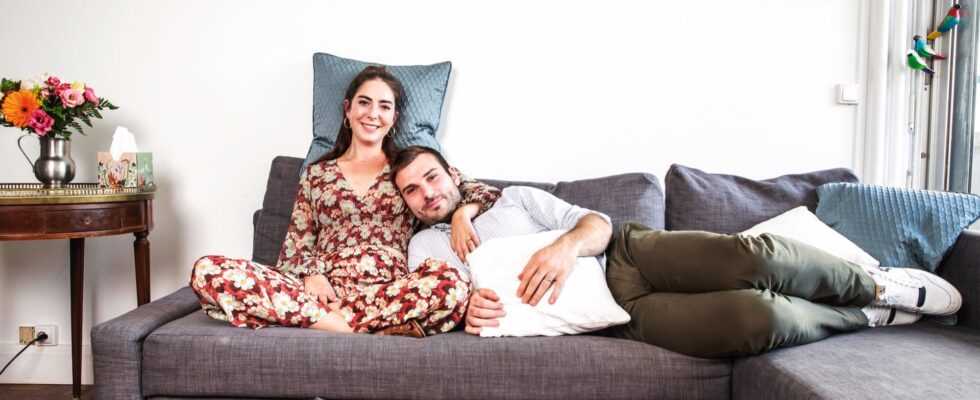Suffering from a neurodegenerative disease so far incurable, this 29-year-old American refuses fatality. And publishes his logbook
Loneliness is what is most lacking. She says it like a rebellious child, with her moving golden eyes. Her chest compressed in a floral blouse rises, jerky breath: “I spend far too much time with my family…” Leah Stavenhagen looks at her young husband, Hugo, her mother, her sister, all around her, in the living room of his apartment located at the back of a residence near the Place de la Nation. One helps her drink with a straw, one caps her, the other crosses and uncrosses her spindly legs. She guides them with a word, a blink of an eye, a frozen smile. One feels that the spirit is boiling inside, lively, clairvoyant, full of gratitude and exasperation; that he dreams of sending everything crashing down, the respirator tubes that help him get oxygen, the wheelchair, the adored relatives, to whom he must submit for the slightest gesture, even to raise his head.
Read also: “Research should be a national priority” – Charcot’s disease
Damn, living like he was three years ago, before he was diagnosed with Charcot’s disease. ALS, amyotrophic lateral sclerosis, we say in scientific language, a degeneration of motor neurons, these nerve cells that control voluntary muscles, gradually paralyzing walking, speaking, swallowing, breathing… fatal outcome in three to five years. Science does not know how to explain it, genetic anomalies detected in 10% of cases, appearance generally around 55 years of age. Six thousand to eight thousand French people suffer from it, in indifference, except when the news unearths tragedies: this veterinarian recently prosecuted for having provided enough to shorten the suffering of a friend who no longer wanted to live with his ALS, just like the novelist Anne Bert, author of a poignant plea for euthanasia.
Leah’s body gives out, but Hugo doesn’t. He proposes to her under a shower of roses
Leah Stavenhagen, she fuels hope. “I would like to dance again” (ed. de l’Archipel), she writes, with the help of Sarah Gaudron and the support of the actress Clémentine Célarié, who signs the preface. It’s a little combat book, a diary without pathos, the interference of this incurable disease in the life of a young American worthy of “Emily in Paris”.
The young couple wants to continue living as if nothing had happened. In Paris, May 10.
© Claire Delfino / Paris Match
The comparison with the futile heroine of the Netflix series amuses her, she too has sometimes given in to clichés. Saint-Germain-des-Prés, the cafes, the style, he often told his New York mother, who was a student at Sciences Po in the early 1980s before marrying a researcher in immunology from Columbia who became an executive in the pharmaceutical industry. Leah, eldest of their three daughters, learned French, before falling in love, at 19, with a Parisian, Hugo Taubmann, who came to study at his University of Michigan. Together, they continued their studies in the City of Light – he did a master’s degree at Essec, she at the Sorbonne and then at HEC – before becoming consultants. Life spoiled at a hundred miles an hour, trips, outings, friends, jogging and high-dose yoga.
Read also: Jérôme Golmard, his fight against the disease – “I will give everything”
One day, in early 2019, Leah’s body, muscled from years of dancing and synchronized swimming, seemed to falter, suddenly labored stretching, cramps, loss of balance. She ended up talking about it to her gynecologist, who tested her reflexes with a little hammer blow, puzzled pout, advice to consult a neurologist. The specialist asked him to stand on his tiptoes. Impossible. Please do an electromyogram, the test to measure the ability of the nerves to conduct the nerve impulses that activate the muscles. The results were obviously not good as the neurologist was suddenly considerate, refusing to be paid, after having dropped a few scholarly words from which emerged the term ALS. Simple hypothesis, he says, without expanding, better to consult a specialist in neurodegenerative diseases.

With Hugo, Place de la Nation. “A nurse said to me, ‘Be careful that he remains your boyfriend and not just your life assistant.’ We take care of it…”, smiles Leah.
© Claire Delfino / Paris Match
Of course, Leah typed “SLA” on Google and hell appeared: snuffed lives, especially among great athletes, a few celebrities, including comedian Jean-Yves Lafesse and astrophysicist Stephen Hawking, everywhere in photos, monstrous. Dizziness, quickly closing up, clinging to other possible diagnoses. Hugo and she moved heaven and earth to consult the best, in Paris, at Pitié-Salpêtrière, in New York, in Massachusetts, where a specialist immediately demanded $ 1,700 for a video consultation. All prescribed additional examinations. But deep down, Leah knew: climbing stairs seemed like a mountain to her, she fell in the street, in the office, in front of a nightclub, to the point of being suspected of having drunk too much, refused entry one evening. “I’m sick,” she confided to the bouncer, who laughed: “I’ve never had that one done to me!” »
The neurologist tells him to stand on his tiptoes. Impossible.
Finally, after six months, his neurologist at Pitié-Salpêtrière, Timothée Lenglet, gave the verdict: Charcot’s disease. “One day your body will become a prison,” read posters at the hospital. Suddenly she understood, felt. The confinement varies: some are paralyzed, others still walk but can no longer speak, the unlucky accumulate, it’s the lottery. He was advised to “treat his body like a phone battery, saving his strength”. Above all, do not lose muscle mass, fill up on proteins, sugars, fat, not easy when you have always taken care of your line. He had to give up skirts, submit to orthotics, these heavy splints fixed to the feet to be able to walk, before moving on to the wheelchair.

Parisian wedding at the 14th century town hall, October 23, 2020.
© DR
Gradually, it was impossible to go to the office, even to continue teleworking, the fingers could no longer type on the computer keyboard. The body let go, but not Hugo. He asked her in marriage, like in his dreams, diamond, trip on the Seine, champagne, shower of roses. The ceremony took place at the town hall of the 14th arrondissement, in October 2020. He started working from home non-stop; it is he who, every morning, helps Leah to get up, wash, dress… She trained him in make-up, cleaning, cooking. You have to see him try to do everything right, lift her like a doll, lift her chin, unbend her long neck, brush the locks in front of her golden eyes. “My body is spaghetti,” she jokes. But up there, nothing has changed, I’ve always been boring…” He shakes his head “no”, breathes: “We’re together, we fight, it’s normal. »
In France, Leah could not join any of the ongoing trials, which were limited due to the regulatory framework and the lack of resources. “We have set up a multidisciplinary follow-up, to accompany the impact of the disease”, indicates Timothée Lenglet. Physiotherapy, occupational therapy, ventilatory assistance… All of this is useful, free, unlike in the United States. But there appeared a glimmer of hope. A New York neurologist, Neil Shneider, touched by Leah, so young, and by her researcher father, who made a donation to her service, proposed an experimental treatment. It involves injecting stem cells (taken from the umbilical cord of newborns and processed by a Houston biotech, Cellenkos) supposed to limit the inflammation that causes Charcot’s disease to flare up. Green light from the FDA “on a compassionate basis”, without any protocol being validated at this stage for this cell therapy, also explored in Israel. In short, Leah plays the guinea pigs and knows it: “I have nothing to lose”, she says.
“We are together, we face, it’s normal”, says Hugo
First transfusion in June 2020, a dozen others have since been administered and new patients included – including a Frenchman. The young woman wants to remain cautious, hesitates when asked if she feels any progress: “Some days no, others yes, my condition has not deteriorated for a year, but is it linked to the treatment or the normal course? His doctors confirm: impossible to know. She and her husband are exploring all avenues; they have just returned from a road trip from New York to Florida, the state with the most ALS cases and specialized clinics. One of them offers a “holistic method” at 7,000 dollars a week, with injections of substances, vitamins, special food… to depollute the body. Wacky, no proven effectiveness, even if the approach is based on a reality: environmental factors are now frequently put forward in the onset of the disease, epidemiological studies having notably identified a higher prevalence in areas rich in pesticides.
Numerous cases of ALS were also analyzed in a village in Savoie and on the island of Guam, before the researchers discovered that the patients had all ingested an ultra toxic mushroom, the gyromitre, or false morel… Leah herself asks if the origin of the evil would not come from this “stress” which gnaws at her since childhood, or from a virus caught during a trip to Thailand made before the first symptoms. “I would like to understand so much, but above all we have to hold on, until science advances. She supports research with her Instagram account, her blog, her association. At a fundraising dinner in Manhattan a few months ago, she was greeted by comedian Ben Stiller and applauded under Hugo’s emotional gaze. These two promised to dance together, no matter what.
